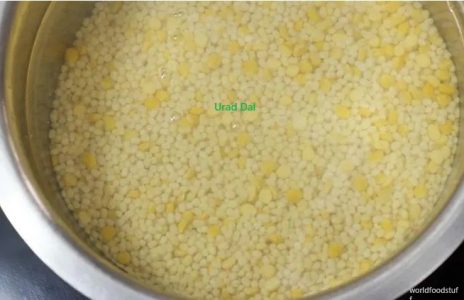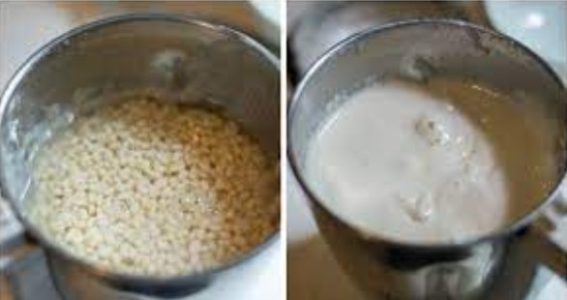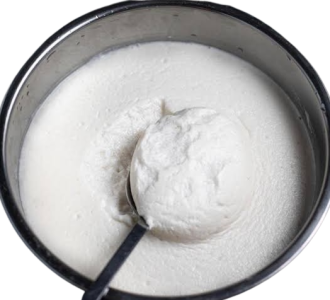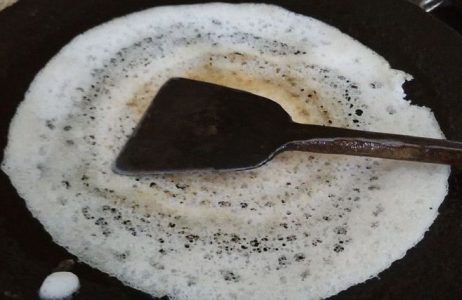Dosa, a crispy and savory pancake originating from South India, is an incredibly popular dish that has won hearts not only in India but across the world. Thin, crispy, and sometimes filled with a spicy potato filling, dosa can be enjoyed with a variety of accompaniments such as coconut chutney, sambar, or tomato-onion chutney. Dosa is equally famous food in south India like idli and sambar. Already we wrote before about how to make idli and how to make tiffin sambar at home. The secret to a perfect dosa lies in the batter. Here’s how you can prepare dosa batter at home and make your own delicious dosa.

Ingredients to Make Dosa at Home | Dosa Batter Recipe
Ingredients:
- Urad dal (split black gram without skin) – 1 cup
- Rice (parboiled rice or idli rice is best) – 2 to 3 cups
- Fenugreek seeds (Methi seeds) – 1 teaspoon
- Salt – to taste
- Water – as required
Instructions:
Soaking:
- Start by washing the urad dal and rice separately under running water until the water runs clear.

- In separate containers, soak the urad dal and rice. Add the fenugreek seeds to the urad dal container.

- Ensure that the ingredients are submerged in ample water as they will expand upon soaking.
- Allow them to soak for a minimum of 5-6 hours, preferably overnight.
Grinding:
- After the soaking period, drain the water from both the rice and the urad dal.
- Using a wet grinder or a high-power blender, grind the urad dal and fenugreek seeds mixture until it forms a smooth, fluffy batter. You might need to add a little water, but do so sparingly.

- Next, grind the rice until it has a slightly grainy texture.

- Combine the two batters in a large container. Add salt and mix well.
Fermentation:
- Cover the container with a lid, but make sure it’s not airtight. This batter needs to ferment, and for that, it requires some air.
- Let the batter ferment in a warm place for 8-10 hours. During colder months, fermentation might take longer. The batter should almost double in volume and have a slightly sour aroma when ready.
- Once fermented, the batter is ready to be used. However, if you aren’t using it immediately, you can store it in the refrigerator.

- Making Dosa:
- Heat a non-stick tawa or flat pan over medium heat.
- Pour a ladleful of dosa batter in the center and using the base of the ladle, quickly spread the batter in a circular motion, moving outwards to form a thin pancake.

- Drizzle a little oil or ghee around the edges of the dosa.
- Let it cook until the bottom gets a golden brown shade and the edges start lifting. If desired, you can flip the dosa and cook for another 30 seconds, but this is not necessary for very thin dosas.

- Remove the dosa using a spatula and serve immediately with your favorite accompaniments.

Tips and Tricks:
- Consistency is Key: The batter should be neither too thick nor too thin. A proper consistency ensures that the dosa spreads well on the pan and turns out crispy.
- Fermentation Factors: The success of the batter largely depends on fermentation. If you’re living in a colder region, you can place the batter inside an oven with the light on or even on top of the refrigerator, where it’s slightly warmer, to aid the fermentation process.
- Non-Stick Pan: Using a non-stick pan ensures the dosa doesn’t stick, making the flipping and removal process smooth. If using an iron griddle, it needs to be well-seasoned.
- Variations: There are numerous dosa variations like masala dosa, cheese dosa, onion dosa, and many more. The base recipe remains the same, with toppings or fillings added as per preference.
Also Read: How To Make French Toast With Pound Cake
Conclusion:
Here we share our best recipe for you. Hope you will success to make south Indian crispy dosa at home. Making dosa at home is a rewarding experience, especially when you break a piece of that crispy pancake and dip it into some tangy sambar or coconut chutney. The process does require some patience, particularly during the fermentation phase, but the results are worth the wait.

